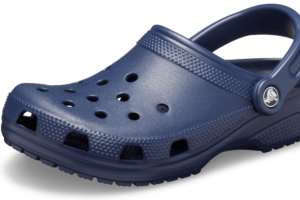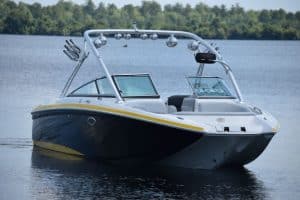If you are a new boater or just interested in boats, there are many boating terms to learn. One of the most common boating terms is the “stern” of the boat or ship. In this article, I’ll define what the stern of a boat or ship is and where it is located.
The stern is the back part or the aft-most portion of a boat or ship. It is constructed over the sternpost (steel bar in the stern that supports the rudder). It extends up to the taffrail (handrail around the ship).
On the other side of the boat or ship, the front or foremost part is called the bow. The simple diagram below shows where the stern is on a boat:
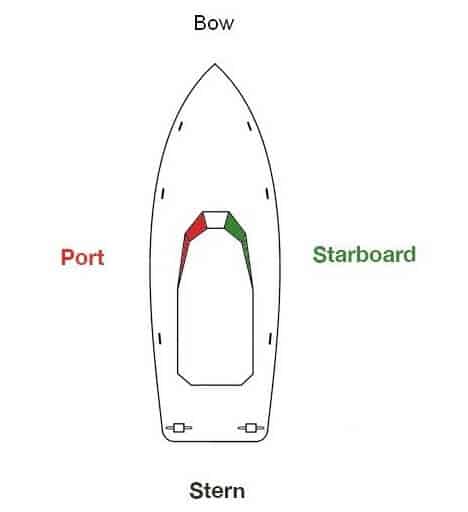
Boating is a pleasurable activity. But to maximize enjoyment, you need to know certain boating terms. There are so many terms, and you don’t have to learn them all. But the stern is a key part of the boat, so it should be well-understood.
Read on and discover everything you need to know about the stern of a boat or ship, including what it is and where it is located.
Stern of a Boat or Ship – What and Where Is It?
The back part of a ship is called the stern. It is exactly opposite the front part of the boat, called the bow. The stern is built on a structural beam called the sternpost, which is where the back end of the ship called transom is attached.
People who go canoeing consider the person at the stern as the one steering. The one paddling at the front (or bow) provides the boat’s power to move forward. The stern of a ship also keeps the water out.
The names of the parts of a ship also refer to directions: the bow is the front, the stern is the rear, the starboard is the right side, and the port is the left side. Most modern boats are equipped with a light at the rear for navigation and to inform other ships about their presence or location at night.
These lights usually glow in white to make the boat visible even at very long distances. On smaller boats, the stern is where the propulsion devices are installed. For example, outboard motors extend into the water from the stern of small boats. Additionally, there are boats wherein their rudders extend into the water from the stern to help in the steering.
What Is the Basic Function of the Stern?
The basic function of the stern is to house the steering device or tiller. It may also be the place where the outboard motor of the boat is installed. This motor is tilted from side to side to make the boat turn.
The outboard motor has a propeller that provides the power to move the boat forward. On a bigger scale, the stern of a ship is usually where the engine room is located. Ships need bigger propulsion power to help them move forward. Often, there are two or more marine engines installed in a large ship to propel it forward or backward.
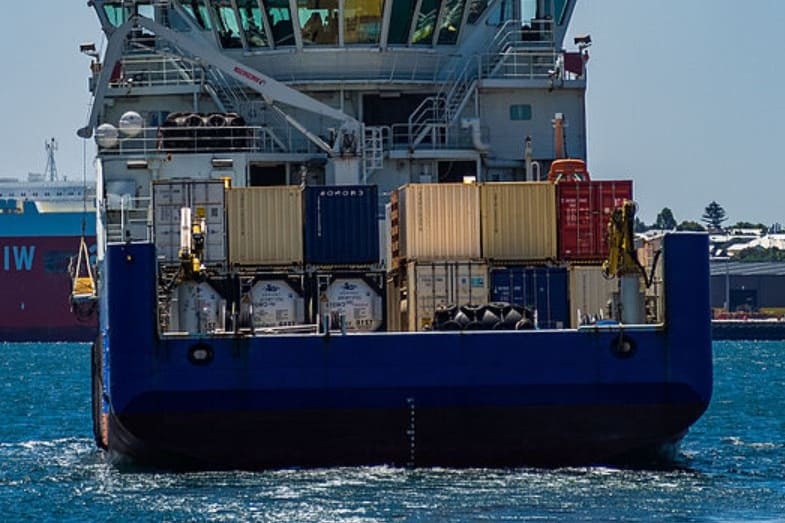
When a seacraft is classified as a ship, it usually has two or more engines that provide its propulsion power. These engines are typically located at the stern of the ship, particularly in the engine room. This room is located far below the ship’s deck.
Location of the Stern
Where is the stern on a boat? The stern is at the back of the ship, where the propeller is usually installed. The engines are typically situated near or in front of the propeller to shorten the distance. The shorter the distance, the less power is dissipated from the engine to the propeller. There are also fewer materials and equipment required to connect the two.
The stern can serve other purposes than just house the engines of a ship or boat. In a small boat, it is not very difficult to see the logic of the question: “Where is the stern of a boat?” This type of seacraft is smaller than an aircraft carrier, so you can see why its engine/propeller is at the back.
But the question: “Where is the stern of a ship located?” is harder to answer if you are not aware of how large ships are built. Most large ships, including ocean cruisers, have their engine rooms located at their sterns. Among other logical reasons, their location reduces the distance between the propeller and the engines to enable an increased forward thrust.
Functions of the Stern
The stern of a big ship serves other functions instead of just being the place where engines are installed. On a cruise ship, the stern may house a dining area. The rear part of a large ship offers the best view of the expansive ocean.
In an aircraft carrier, the stern is the most logical place to place an elevator that takes an aircraft below the deck. The rear of an aircraft carrier is typically free from the landing strip’s normal, hectic traffic at the bow or front of the carrier.
Moreover, in the past, most sterns of ships housed the quarters of the captain. The stern is also called the transom. The transom is highly decorated in some ships, while some have Spartan features used for its basic functions. On modern seacrafts, such as yachts, the stern is often the part of the boat that bears the vessel’s name.
Different Types of Sterns
In building a ship, certain factors must be considered. Some of the more important factors are flow patterns, hydrodynamic efficiency, aesthetics, and simplicity of construction.
Also, some elements must be considered in choosing the right style and design of sterns. They include the following:
- The stern must be able to prevent vibrations.
- Its design must ensure a uniform flow of water to the propeller to achieve high propulsion efficiency.
- The design of the stern should reduce resistance.
In adhering to these parameters, ship and boat designers came up with three broad types of stern styles: the transom stern, cruiser stern, and elliptical stern. These three styles refer to the top side of the stern. There is also the underwater form of the stern.
Ship and boat designers are paying considerable attention to the stern design to improve the flow of water into and away from the propeller. In the past, most designers favor the cruiser stern design for sea vessels. Today, they are building ocean-going vessels that have transom sterns.
So we’ve answered the question, ‘what is the stern of a boat’ or ‘what is the stern of a ship’; Next, we’ll answer, ‘what is a transom stern’; ‘what is a cruiser stern’; and ‘what is an elliptical stern’?
Transom Stern
What is a transom stern? The shape of a transom stern is basically flat all the way to the waterline. This shape produces greater space in the aft deck area. It is not just easier and simpler to construct, but it also improves the flow of water around the stern. The transom stern’s flat surface may start at or above the vessel’s waterline.
This type of stern design, especially its underside, affects the propulsion efficiency of the boat. If there is less turbulence in the space between the outer shell of the ship above the propeller and the propeller itself, its efficiency will increase.
But the deck of transom sterns will easily get wet when the ship goes in reverse mode and during heavy seas. In such cases, the water is damped up. The ship’s flare and knuckle are used to avoid flooding the deck and deflect water when the ship is astern or reversing.
Cruiser Stern
What is a cruise stern? When it was first designed, a cruiser stern was intended to reduce the height of the steering gear located beneath the armor deck. This type of stern has a curved profile going upwards, coming from the aft perpendicular to the poop or main deck.
The cutaway in a cruiser stern is not like that of a counter stern. Its rudder is placed below the waterline, where it is fully submerged. This type of stern has improved resistance capabilities compared to the merchant stern. It is more hydrodynamically efficient, and its profile is more aesthetically pleasing.
Elliptical Stern
What is an elliptical stern? The elliptical stern is also called the counter or merchant stern. It was the conventional stern design for cargo ships in the early 20th century. The deck line and the knuckle line, when viewed from above, have an elliptical shape.
It has an upward and curved profile. The cutaway for the counter stern is located above the waterline. Therefore, this stern has an exposed skeg and a pronounced aft overhang.
This type of stern allows for larger deck space. It offers an excellent aesthetic option to the owner as well. Reserve buoyancy of the ship is also increased measurably with counter sterns.
Styles of Sterns or Transoms
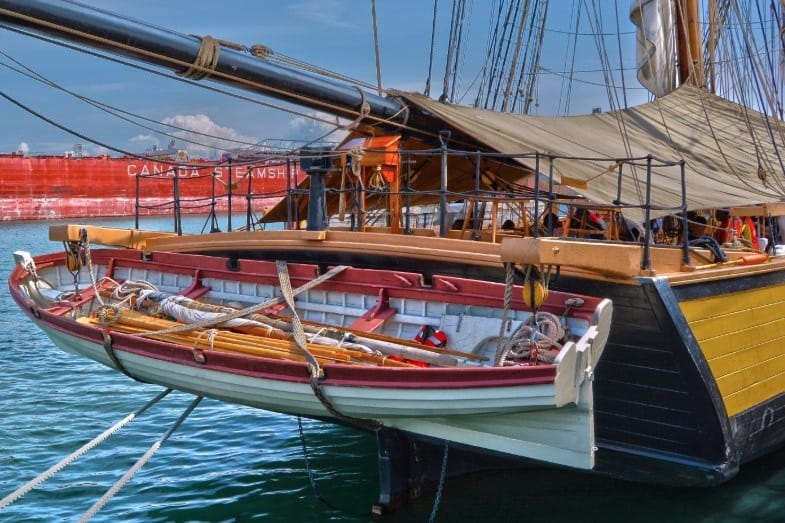
Sterns are also constructed in different styles. In other words, they all don’t look the same. Sterns vary in angle, width, and overall style. But there are four common styles of sterns or transoms. They are raked, reverse, canoe, and flat.
- Raked Stern – This style has adapted by boats for racing. Its design streamlines the movement of the boat through the water. Moreover, boats with this style tend to have longer bows.
- Reverse Stern – This style is more angular in shape and often has steps that make it easy for passengers to disembark from the boat. Swim steps and handrails are usually added in the transom area.
- Canoe Stern – This style is more aerodynamics, maybe because of its circular shape. It enables the pushing away of more water at the backside of the boat.
- Flat Stern – This style has a broad vertical face and appears semicircular at the back.
Style is not the only factor that determines how the stern is built and where the stern is located on the boat. The functionality and utility of the area also come into the picture. Most boats have sterns that have chocks and cleats to secure the sails, dock lines, mooring, and many more.
You need the right hardware to be able to enjoy your time in the water. All this hardware must be immovable and secure at the stern. A boat with all excellent features won’t give you a great time on the water if its stern cannot give you such functionality features.
Boat Stern Lights
Recreational boats are required to turn on their navigation lights between sunset and sunrise for safety purposes. Stern lights are included in this regulation. Below are some of the stern lights that you can consider for your boat:
1. TOTAL MARINE Pac Trade Boat LED Transom Stern Light
The TOTAL MARINE Pac Trade Boat LED Transom Stern Light is an SS 304 flush mount bulb navigation light. It is a 1×1 cool white LED splash-proof 120 degrees light with 60 LM beam angle effective lumen.
Click here to see it on Amazon.
2. 2″ White LED Marine Navigation Anchor All-Round Boat Light
This 2″ White LED Marine Navigation Anchor All-Round Boat Light is a 12” all-round light that can function in all weather conditions. It is silicone-sealed, fully submersible, and IP 67 rated.
Click here to see it on Amazon.
3. White Stern LED Marine Navigation Light [IP67 Waterproof] [USCG Approved]
The White Stern LED Marine Navigation Light [IP67 Waterproof] is another boat stern light of high quality. It is USCG-approved, meets the ABYC standard A-16, and is visible up 2 NM. It can be used in boats as long as 65.6 feet or 20 meters.
Click here to see it on Amazon.
Conclusion – Stern of a Boat or Ship – What and Where Is It?
So, to recap, what is the stern of a boat or ship, and where is it located? The stern is in the back part of the boat or ship. It is the aft-most portion of the ship or boat.
In technical terms, it is the part of a ship or boat built on top of the sternpost. It extends up to the taffrail (the handrail around the edge of the boat). Its location is on the opposite part of the front or foremost part of the ship, called the bow.
Related reading:




![TRUE MODS White Stern LED Marine Navigation Light [IP67 Waterproof]](https://m.media-amazon.com/images/I/31bT9XPZNOL._SL500_.jpg)



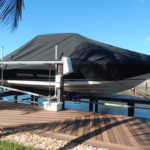

![Boat Floor Replacement Plywood [Best Options] boat floor replacement plywood](https://boatinggeeks.com/wp-content/uploads/2021/07/boat-floor-replacement-plywood-150x150.jpg)
![Read more about the article Impeller Vs Propeller [What Is the Difference Between Them?]](https://boatinggeeks.com/wp-content/uploads/2021/07/difference-between-impeller-and-propeller-300x200.jpg)
